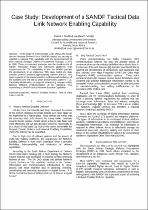 ResearchSpace
ResearchSpace
Case study: development of a SANDF tactical data link network enabling capability
JavaScript is disabled for your browser. Some features of this site may not work without it.
- ResearchSpace
- →
- Research Publications/Outputs
- →
- Conference Publications
- →
- View Item
| dc.contributor.author |
Smith, CJ

|
|
| dc.contributor.author |
Venter, JP

|
|
| dc.date.accessioned | 2011-12-01T08:07:36Z | |
| dc.date.available | 2011-12-01T08:07:36Z | |
| dc.date.issued | 2011-11 | |
| dc.identifier.citation | Smith, CJ and Venter, JP. 2011. Case study: development of a SANDF tactical data link network enabling capability. Military Communications and Information Systems Conference (MilCIS 2011), Canberra, Australia, 8-10 November 2011 | en_US |
| dc.identifier.uri | http://hdl.handle.net/10204/5355 | |
| dc.description | Military Communications and Information Systems Conference (MilCIS 2011), Canberra, Australia, 8-10 November 2011 | en_US |
| dc.description.abstract | In the scope of Tactical Data Links (TDL), the South African National Defence Force (SANDF) started the journey to establish a national TDL capability with the commencement of their national Strategic Defence Procurement Packages (SDPP) in 1999. These procurement packages saw the development of fighter, helicopter, frigate and submarine platforms with requirements for TDL capabilities. In this, the SANDF pursued the development of an indigenous TDL data model and data transfer protocol standard appropriately named Link-ZA. This paper expands on the implementation evolution and challenges of the standard over the last 10 years and provides a generic TDL Capability Model with a strategy for establishing interoperability between different implementations of the standard, thus establishing a SANDF tactical Network Enabled Capability. | en_US |
| dc.language.iso | en | en_US |
| dc.publisher | MilCIS 2011 | en_US |
| dc.relation.ispartofseries | Workflow request;7053 | |
| dc.subject | Network enabled defence | en_US |
| dc.subject | Tactcial data links | en_US |
| dc.subject | Military communications | en_US |
| dc.subject | SANDF tactical data link network | en_US |
| dc.subject | SANDF | en_US |
| dc.subject | MilCIS 2011 | en_US |
| dc.title | Case study: development of a SANDF tactical data link network enabling capability | en_US |
| dc.type | Conference Presentation | en_US |
| dc.identifier.apacitation | Smith, C., & Venter, J. (2011). Case study: development of a SANDF tactical data link network enabling capability. MilCIS 2011. http://hdl.handle.net/10204/5355 | en_ZA |
| dc.identifier.chicagocitation | Smith, CJ, and JP Venter. "Case study: development of a SANDF tactical data link network enabling capability." (2011): http://hdl.handle.net/10204/5355 | en_ZA |
| dc.identifier.vancouvercitation | Smith C, Venter J, Case study: development of a SANDF tactical data link network enabling capability; MilCIS 2011; 2011. http://hdl.handle.net/10204/5355 . | en_ZA |
| dc.identifier.ris | TY - Conference Presentation AU - Smith, CJ AU - Venter, JP AB - In the scope of Tactical Data Links (TDL), the South African National Defence Force (SANDF) started the journey to establish a national TDL capability with the commencement of their national Strategic Defence Procurement Packages (SDPP) in 1999. These procurement packages saw the development of fighter, helicopter, frigate and submarine platforms with requirements for TDL capabilities. In this, the SANDF pursued the development of an indigenous TDL data model and data transfer protocol standard appropriately named Link-ZA. This paper expands on the implementation evolution and challenges of the standard over the last 10 years and provides a generic TDL Capability Model with a strategy for establishing interoperability between different implementations of the standard, thus establishing a SANDF tactical Network Enabled Capability. DA - 2011-11 DB - ResearchSpace DP - CSIR KW - Network enabled defence KW - Tactcial data links KW - Military communications KW - SANDF tactical data link network KW - SANDF KW - MilCIS 2011 LK - https://researchspace.csir.co.za PY - 2011 T1 - Case study: development of a SANDF tactical data link network enabling capability TI - Case study: development of a SANDF tactical data link network enabling capability UR - http://hdl.handle.net/10204/5355 ER - | en_ZA |





